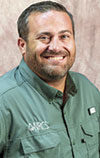Sometimes, you don’t just need a plan, you need plan A, B and then even C, especially when it comes to water resources for your livestock. There is nothing quite like drought conditions to really drive that point home.
Located just 18 miles south of Colorado City, Texas, Kregg and Diana McKenny raise cattle and farm his family farm, which they now homestead. Early on, it was evident that water was more important than electricity for the farm’s success. Kregg’s grandparents purchased the farm in 1943 before there was a power grid in place, and they used alternative power sources until the power was brought in eight years later.
They survived the drought of the 1950s and their water well continued to provide the required water for their home and livestock. Kregg’s ancestors were very resourceful, capturing available rainwater by catching water on every house on the farm using a cistern. More than 70 years later, Kregg has built gutter systems with storage tanks to capture the rainwater just like his ancestors had done.
“The water well sustained us through the drought of the 1950s, which gave me a false confidence, and we learned it the hard way in the drought of 2009 when the well went dry and we had to haul water and ultimately sell all my livestock except for two retired horses,” Kregg states. “The water came back to my well nine months later when the rains recharged our aquifer, which made me realize I needed a plan B and C.”
In 2011 for plan B, Kregg drilled another well that was deeper and thought it would be sufficient, but it wasn’t enough. At this point, Kregg went to the local USDA Natural Resources Conservation Service (NRCS) office to discuss water source alternatives, and he was able to work with Derrick Fuchs, NRCS rangeland management specialist, to develop plan C.
“Our initial plan was to reduce his mesquite canopy through brush management along with installing a rainwater catchment utilizing the surface area of his barn and adding storage to increase his water source capabilities,” explains Fuchs. “The NRCS has a diverse staff, and we were able to use an NRCS agriculture engineer to design the gutters and storage facilities. The 3,500-gallon storage tank ended up being filled in three rainfall events and hasn’t gone dry since.”
Applying for the Environmental Quality Incentives Program (EQIP), Kregg was able to clear his dense canopy of mesquite, which allowed water to grow forage plants for grazing as well as recharge the aquifer. He also added a water catchment system to harvest rainfall from his barn roof.
“Working with the NRCS was very easy with Derrick getting a plan in place while giving me ideas to think about for the long term that I hadn’t really thought about before,” says Kregg. “After the funding was secured, I was able to implement some of the action items in my conservation plan. Now I am thinking of the next step with my cattle, even though I still get leery of stocking too heavily and tend to be more conservative because I don’t ever want to have to destock like I did in 2009.”
After clearing invasive mesquite and reestablishing the pastures to native grass, he has been able to think more about sustainability, improve his water distribution and begin a new grazing management plan. This will give his cattle smaller pastures while moving them often. The grazing plan will allow the cattle to graze the entire pasture, which they would normally not utilize. This system is called high-intensity, low-frequency. This system will allow more rest to the pastures between grazing events while allowing hoof action to incorporate nutrients into the soil. Kregg is still in the planning process of building cross fences but also plans to use temporary electric fencing.
“I look at my management from different facets including brush control, water distribution and storage with proper stocking rates and a drought plan in place. This means you have to know if you can reduce livestock once the rain stops,” explains Kregg. “I had waist-high grass this past year and I still get worried about overstocking. My main concern always goes back to 2011 and having to destock because I had no water for my cattle.”
To compound the drought issues in 2011, a wildfire consumed most of his ranch and destroyed most of his fencing that year. High winds carried the fire with high intensity and burned out every wooden post, destroying the wire in the process. He was able to utilize farm bill programs to rebuild his fences.
“I will encourage everyone to build metal fences because the fire was so hot with high winds that the posts burned out completely and added heat to the wire, which caused it to be ruined and had to be replaced. But I was lucky, the USDA was able to help me get those replaced so I could get back to ranching” Kregg says.
While it is dry in West Texas and the rains are infrequent, alternatives can often be found by looking at the past while looking toward a future of sustainability and land stewardship.
“My step-dad always told me when I was younger to always have two waters sources. He sure was right, and now I have three water sources – to be able to provide for livestock even during drought situations,” says Kregg. ![]()
Donnie Lunsford is a Natural Resources Conservation Service public affairs specialist. Email Donnie Lunsford.
—From USDA news release
PHOTO: Kregg McKenny sits with his dog looking over his herd that he is about to move into a new grazing cell utilizing electric fencing in his high-intensity, low-frequency grazing system. Photo courtesy of the NRCS.











